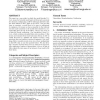Free Online Productivity Tools
i2Speak
i2Symbol
i2OCR
iTex2Img
iWeb2Print
iWeb2Shot
i2Type
iPdf2Split
iPdf2Merge
i2Bopomofo
i2Arabic
i2Style
i2Image
i2PDF
iLatex2Rtf
Sci2ools
EMSOFT
2006
Springer
2006
Springer
Analysis of the zeroconf protocol using UPPAAL
We report on a case study in which the model checker Uppaal is used to formally model parts of Zeroconf, a protocol for dynamic configuration of IPv4 link-local addresses that has been defined in RFC 3927 of the IETF. Our goal has been to construct a model that (a) is easy to understand by engineers, (b) comes as close as possible to the informal text (for each transition in the model there should be a corresponding piece of text in the RFC), and (c) may serve as a basis for formal verification. Our conclusion is that Uppaal, which combines extended finite state machines, C-like syntax and concepts from timed automata theory, is able to model Zeroconf in a faithful and intuitive manner, using notations that are familiar to protocol engineers. Our modeling efforts revealed several errors (or at least ambiguities) in the RFC that no one else spotted before. We also identify a number of points where Uppaal still can be improved. plying a number of abstractions, Uppaal is able to fully ex...
| Added | 22 Aug 2010 |
| Updated | 22 Aug 2010 |
| Type | Conference |
| Year | 2006 |
| Where | EMSOFT |
| Authors | Biniam Gebremichael, Frits W. Vaandrager, Miaomiao Zhang |
Comments (0)

